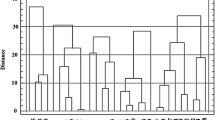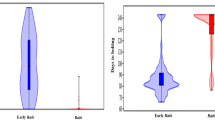Abstract
The heading characters and morphological traits of two partial sets of wheat–barley disomic addition lines, namely Mv9kr1/Igri and Asakaze/Manas, were evaluated under controlled environmental conditions in a phytotron under long-day, short-day and non-vernalised conditions and in field-sown experiments. The winter barley chromosome additions significantly influenced the flowering time of wheat both in the controlled environment test and under field-sown conditions. Of all the barley addition lines, the effect of the 4H and 7H additions was the most characteristic. The 7H addition lines were the earliest in both cultivar combinations in each treatment. In the Mv9kr1/Igri combination the 4H addition was the latest under all the environmental conditions. In the Asakaze/Manas combination 4H addition was the latest under short-day and long-day illumination in the phytotron but the 6H addition was the latest without vernalisation and in the field in 2012. There was 12 and 11 days difference between the flowering times of the 7H and 4H Mv9kr1/Igri and Asakaze/Manas addition lines in the field in 2012, which increased to 52 and 44 days under short-day illumination in the phytotron. In the winter wheat background, the addition of 2H carrying the photoperiod sensitivity gene Ppd-H1 decreased the flowering time under the short photoperiod regime, but had a very strong delaying effect under field-grown conditions. Considering the yield components under field conditions, 4H was the most fertile of the addition lines, while 7H showed the highest tillering capacity, and Igri 3H had good tillering capacity and the highest number of seeds per plant.

Similar content being viewed by others
References
Beales J, Turner A, Griffiths S, Snape JW, Laurie DA (2007) A pseudo-response regulator is misexpressed in the photoperiod insensitive Ppd-D1a mutant of wheat (Triticum aestivum L.). Theor Appl Genet 115:721–733. doi:10.1007/s00122-007-0603-4
Chao S, Sharp PS, Worland AJ, Warham EJ, Koebner RMD, Gale MD (1989) RFLP-based genetic maps of wheat homoeologous group of chromosomes. Theor Appl Genet 789:495–504. doi:10.1007/BF00290833
Cockram J, Jones H, Leigh FJ, O’Sullivan D, Powell W, Laurie DA, Greenland AJ (2007) Control of flowering time in temperate cereals: genes, domestication, and sustainable productivity. J Exp Bot 58:1231–1244. doi:10.1093/jxb/erm042
Diallo A, Kane N, Agharbaoui Z, Badawi M, Sarhan F (2010) Heterologous expression of wheat vernalization 2 (TaVRN2) gene in arabidopsis delays flowering and enhances freezing tolerance. PLoS One 5(1):e8690. doi:10.1371/journal.pone.0008690
Distelfeld A, Li C, Dubcovsky J (2009) Regulation of flowering in temperate cereals. Curr Opin Plant Biol 12:178–184. doi:10.1016/j.pbi.2008.12.010
Dubcovsky J, Lijavetzky D, Appendino L, Tranquilli G (1998) Comparative RFLP mapping of Triticum monococcum genes controlling vernalization requirement. Theor Appl Genet 97:968–975. doi:10.1007/s001220050978
Farshadfar E, Mohammadi R, Aghaee M, Vaisi Z (2012) GGE biplot analysis of genotype x environment interaction in wheat-barley disomic addition lines. AJCS 6:1074–1079
Faure S, Higgins J, Turner A, Laurie DA (2007) The flowering locus T-like gene family in barley (Hordeum vulgare). Genetics 176:599–609. doi:10.1534/genetics.106.069500
Fu D, Szűcs P, Yan L, Helguera M, Skinner JS, von Zitzewitz J, Hayes PM, Dubcovsky J (2005) Large deletions within the first intron in VRN-1 are associated with spring growth habit in barley and wheat. Mol Gen Genomics 273:54–65. doi:10.1007/s00438-004-1095-4
Greenup A, Peacock WJ, Dennis ES, Trevaskis B (2009) The molecular biology of seasonal flowering-responses in arabidopsis and the cereals. Ann Bot 103:1165–1172. doi:10.1093/aob/mcp063
Griffiths S, Dunford RP, Coupland G, Laurie DA (2003) The evolution of constans-like gene families in barley, rice, and arabidopsis. Plant Physiol 131:1855–1867. doi:10.1104/pp.102.016188
Hoffmann B, Aranyi NR, Molnár-Láng M (2010) Characterization of wheat-barley introgression lines for drought tolerance. Acta Agron Hung 58:211–218. doi:10.1556/AAgr.58.2010.3.3
Islam AKMR, Shepherd KW (1990) Incorporation of barley chromosomes into wheat. In: Bajaj YPS (ed) Biotechnology in agriculture and forestry. Wheat, vol 13. Springer-Verlag, Berlin, pp 128–151
Islam AKRM, Shepherd KW, Sparrow DHB (1978) Production and characterization of wheat:barley addition lines. Proceedings of the 5th international wheat genetics symposium. Indian Society of Genetics and Plant Breeding. New Delhi, India:356–371
Kane NA, Danyluk J, Tardif G, Ouellet F, Laliberté JF, Limin AE, Fowler DB, Sarhan F (2005) TaVRT-2 a member of the StMADS-11 clade of flowering repressors, is regulated by vernalization and photoperiod in wheat. Plant Physiol 138:2354–2363. doi:10.1104/pp.105.061762
Karsai I, Szűcs P, Mészáros K, Filichkina T, Hayes PM, Skinner JS, Láng L, Bedő Z (2005) The Vrn-H2 locus is a major determinant of flowering time in a facultative × winter growth habit barley (H. vulgare L.) mapping population. Theor Appl Genet 110:1458–1466. doi:10.1007/s00122-005-1979-7
Karsai I, Mészáros K, Szűcs P, Hayes PM, Láng L, Bedő Z (2006) The Vrn-H2 locus (4H) is influenced by photoperiod and is a major determinant of plant development and reproductive fitness traits in a facultative × winter barley (H. vulgare L.) mapping population. Plant Breeding 125:468–472. doi:10.1111/j.1439-0523.2006.01266.x
Koba T, Handa T, Shimada T (1991) Efficient production of wheat-barley hybrids and preferential elimination of barley chromosomes. Theor Appl Genet 81:285–292. doi:10.1007/BF00228665
Koba T, Takumi S, Shimada T (1997) Isolation, identification and characterization of disomic and translocated barley chromosome addition lines of common wheat. Euphytica 96:289–296. doi:10.1023/A:1003081619338
Molnár-Láng M, Linc G, Sutka J (1996) Transfer of the recessive crossability allele kr1 from Chinese spring into the winter wheat variety Martonvasari 9. Euphytica 90:301–305. doi:10.1007/BF00027480
Molnár-Láng M, Linc G, Logojan A, Sutka J (2000) Production and meiotic pairing behaviour of new hybrids of winter wheat (Triticum aestivum) × winter barley (Hordeum vulgare). Genome 43:1045–1054. doi:10.1139/g00-079
Molnár-Láng M, Novotny C, Linc G, Nagy ED (2005) Changes in the meiotic pairing behaviour of a winter wheat-winter barley hybrid maintained for a long term in tissue culture, and tracing the barley chromatin in the progeny using GISH and SSR markers. Plant Breeding 124:247–252. doi:10.1111/j.1439-0523.2005.01097.x
Molnár-Láng M, Kruppa K, Cseh A, Bucsi J, Linc G (2012) Identification and phenotypic description of new wheat—six-rowed winter barley disomic additions. Genome 55:302–311
Murai K, Koba T, Shimada T (1997) Effects of barley chromosome on heading characters in wheat-barley chromosome addition lines. Euphytica 96:281–287. doi:10.1023/A:1003025501591
Snape JW, Butterworth K, Whitechurch E, Worland AJ (2001) Waiting for fine times: genetics of flowering time in wheat. Euphytica 119:185–190. doi:10.1023/A:1017594422176
Szakács É, Molnár-Láng M (2007) Development and molecular cytogenetic identification of new winter wheat-winter barley (‘Martonvasari 9 kr1’-’Igri’) disomic addition lines. Genome 50:43–50. doi:10.1139/g06-134
Szakács É, Molnár-Láng M (2010) Identification of new winter wheat—winter barley addition lines (6HS and 7H) using fluorescence in situ hybridization and the stability of the whole ‘Martonvasari 9 kr1’-’Igri’ addition set. Genome 53:35–44. doi:10.1139/G09-085
Szűcs P, Karsai I, von Zitzewitz J, Cooper LDD, Gu YQ, Chen THH, Hayes PM, Anderson O, Skinner JS (2006) Positional relationships between photoperiod response QTL and photoreceptor and vernalization genes in barley. Theor Appl Genet 112:1277–1285. doi:10.1007/s00122-006-0229-y
Taketa S, Choda M, Ohashi R, Ichii M, Takeda K (2002) Molecular and physical mapping of a barley gene on chromosome arm 1HL that causes sterility in hybrids with wheat. Genome 45:617–625. doi:10.1139/g02-024
Tischner T, Kőszegi B, Veisz O (1997) Climatic programmes used in the Martonvásár phytotron most frequently in recent years. Acta Agron Hung 45:85–104
Tottman DR (1987) The decimal code for the growth stages of cereals, with illustrations. Ann Appl Biol 110:441–454. doi:10.1111/j.1744-7348.1987.tb03275.x
Trevaskis B (2010) The central role of the vernalization1 gene in the vernalization response of cereals. Funct Plant Biol 37:479–487. doi:10.1071/FP10056
Turner A, Beales J, Faure S, Dunford RP, Laurie DA (2005) The pseudo-response regulator Ppd-H1 provides adaptation to photoperiod in barley. Science 310:1031–1034. doi:10.1126/science.1117619
von Zitzewitz J, Szűcs P, Dubcovsky J, Yan L, Pecchioni N, Francia E, Casas A, Chen THH, Hayes PM, Skinner JS (2005) Molecular and structural characterization of barley vernalization genes. Plant Mol Biol 59:449–467. doi:10.1007/s11103-005-0351-2
Yan L, Helguera M, Kato K, Fukuyama S, Sherman J, Dubcovsky J (2004a) Allelic variation at the VRN-1 promoter region in polyploid wheat. Theor Appl Genet 109:1677–1686. doi:10.1007/s00122-004-1796-4
Yan L, Loukoianov A, Blechl A, Tranquilli G, Ramakrishna W, SanMiguel P, Bennetzen JL, Echenique V, Dubcovsky J (2004b) The wheat VRN2 gene is a flowering repressor down-regulated by vernalization. Science 303:1640–1644. doi:10.1126/science.1094305
Yan L, Fu D, Li C, Blechl A, Tranquilli G, Bonafede M, Sanchez A, Valarik M, Yasuda S, Dubcovsky J (2006) The wheat and barley vernalization gene VRN3 is an orthologue of FT. P Natl Acad Sci USA 103:19581–19586. doi:10.1073/pnas.0607142103
Zhu X, Tan C, Cao S, Yan L (2011) Molecular differentiation of null alleles at ZCCT-1 genes on the A, B, and D genomes of hexaploid wheat. Mol Breeding 27:501–510. doi:10.1007/s11032-010-9447-8
Acknowledgments
This work was financed by the Hungarian National Scientific Research Fund (OTKA K 75381 and K 104382), by a Bolyai János Research Fellowship to IM and by TÁMOP grant No. 4.2.2. A-11/1 KONV–2012–0064. The technical assisstance of Julianna Bucsi is gratefully acknowledged. Thanks are due to Barbara Hooper for revising the manuscript linguistically.
Author information
Authors and Affiliations
Corresponding author
Rights and permissions
About this article
Cite this article
Farkas, A., Molnár, I., Kiss, T. et al. Effect of added barley chromosomes on the flowering time of new wheat/winter barley addition lines in various environments. Euphytica 195, 45–55 (2014). https://doi.org/10.1007/s10681-013-0970-7
Received:
Accepted:
Published:
Issue Date:
DOI: https://doi.org/10.1007/s10681-013-0970-7




